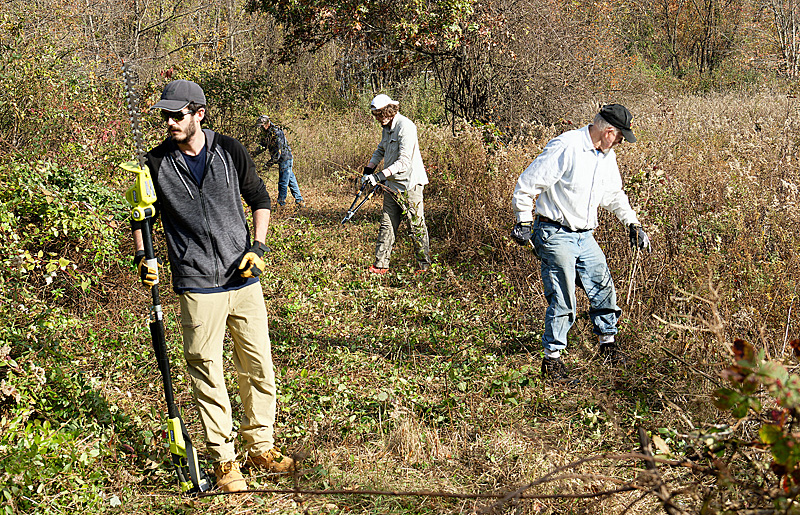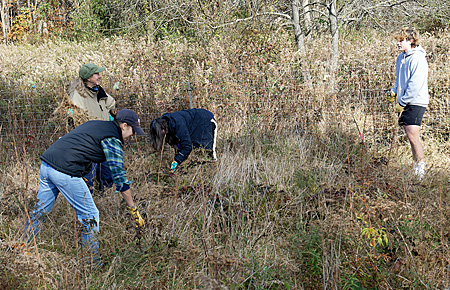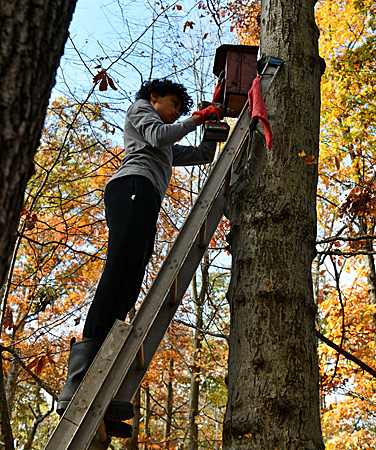Under sunny skies with increasingly warm temperatures, 18 volunteers tackled many different projects at the monthly work day at JK Black Oak Wildlife Sanctuary on November 4. One group started with moving an existing brush pile to a new location and clearing an area for a future shelter. Moving the brush pile with about a dozen people went quickly. Clearing the rest of the area included removal of the ever-present Autumn Olive and Multiflora Rose. The brush pile quickly grew in length and height as we kept adding more and more Autumn Olive on top of it.

The path to the new shelter area.
Photo by Gerco Hoogeweg
Cutting a path to the area for the shelter was tougher because we had to wade through thorny shrubs and vines. Armed with loppers and a battery-powered pole hedge trimmer, we were able to get through it with a few scratches and some thorns stuck in our gloves.
Meanwhile, a small group of volunteers split off to do some maintenance work on one of the vernal pools. In the past couple of years, large branches had come down and needed to be removed when the pool was dry. Some of the branches were so large that several volunteers had to team up to remove them. With the dead wood removed, the pool is ready for the next phase of maintenance: cutting back the Common Greenbrier that has completely overrun the pool in the last two years, making it unsuitable for use by wildlife.

Working in the planting area.
Photo by Gerco Hoogeweg
The tree cages that were installed earlier in the year at the edge of the forest were being overtaken by invasive vines such as Japanese Honeysuckle and Oriental Bittersweet. Removing these vines was taken care of fairly easily. In a couple of the cages where we had planted Common Elderberry, self-seeded oak seedlings were growing surprisingly quickly, outpacing the elderberry. We left them and will see what happens. The elderberry will probably catch up and outgrow the oaks for a while.

Installing a flying squirrel box.
Photo by Gerco Hoogeweg
In the meadow nearby, another small group of volunteers were working in one of the planting areas where native plants rescued from the western meadow in 2021 had been planted. Over the past two years, Lindheimer’s Panic Grass had moved in and was growing in large patches. This native grass would not usually be a problem, but White-tailed Deer love to sleep on top of it, crushing any plants beneath it. When the flattened grass turns brown in the fall, it forms a mat thick enough to keep light from penetrating, which will prevent other natives from emerging in the spring. Pulling and cutting the panic grass was a very labor-intensive process, but eventually we were able to create bare patches of ground and sow seeds. We also discovered many small Common Blackberry shrubs that needed removing along with a few small trees.
The highlight, and perhaps the biggest challenge, of the work day was hanging up four flying squirrel boxes. These boxes needed to be at least 10 feet up the trunk of a tree, but preferably 15 to 20 feet high. Standing near the top of a ladder with a heavy box and drill was not easy. Making sure that the ladder was stable required at least two people to hold it in place. With the first box, we discovered that the screws were not long enough for trees with deep, rough bark. The search for trees with smoother bark was on. Once we found suitable trees, several of our high school volunteers took the lead in hanging up the boxes. It was a fun experience for all.

